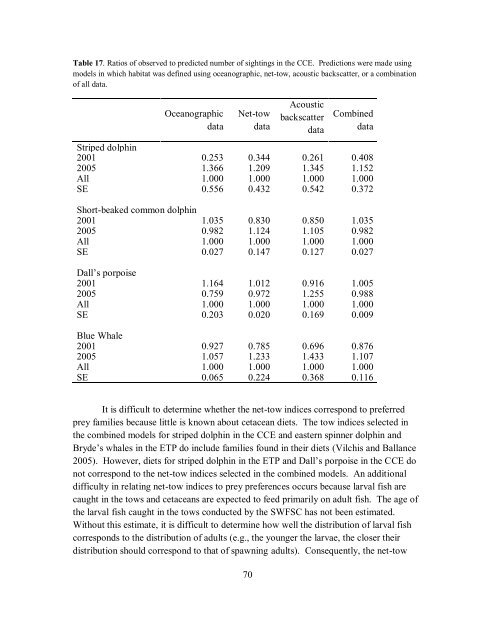Final Technical Report: - Southwest Fisheries Science Center - NOAA
Final Technical Report: - Southwest Fisheries Science Center - NOAA
Final Technical Report: - Southwest Fisheries Science Center - NOAA
Create successful ePaper yourself
Turn your PDF publications into a flip-book with our unique Google optimized e-Paper software.
Table 17. Ratios of observed to predicted number of sightings in the CCE. Predictions were made using<br />
models in which habitat was defined using oceanographic, net-tow, acoustic backscatter, or a combination<br />
of all data.<br />
Oceanographic<br />
data<br />
Net-tow<br />
data<br />
70<br />
Acoustic<br />
backscatter<br />
data<br />
Combined<br />
data<br />
Striped dolphin<br />
2001 0.253 0.344 0.261 0.408<br />
2005 1.366 1.209 1.345 1.152<br />
All 1.000 1.000 1.000 1.000<br />
SE 0.556 0.432 0.542 0.372<br />
Short-beaked common dolphin<br />
2001 1.035 0.830 0.850 1.035<br />
2005 0.982 1.124 1.105 0.982<br />
All 1.000 1.000 1.000 1.000<br />
SE 0.027 0.147 0.127 0.027<br />
Dall’s porpoise<br />
2001 1.164 1.012 0.916 1.005<br />
2005 0.759 0.972 1.255 0.988<br />
All 1.000 1.000 1.000 1.000<br />
SE 0.203 0.020 0.169 0.009<br />
Blue Whale<br />
2001 0.927 0.785 0.696 0.876<br />
2005 1.057 1.233 1.433 1.107<br />
All 1.000 1.000 1.000 1.000<br />
SE 0.065 0.224 0.368 0.116<br />
It is difficult to determine whether the net-tow indices correspond to preferred<br />
prey families because little is known about cetacean diets. The tow indices selected in<br />
the combined models for striped dolphin in the CCE and eastern spinner dolphin and<br />
Bryde’s whales in the ETP do include families found in their diets (Vilchis and Ballance<br />
2005). However, diets for striped dolphin in the ETP and Dall’s porpoise in the CCE do<br />
not correspond to the net-tow indices selected in the combined models. An additional<br />
difficulty in relating net-tow indices to prey preferences occurs because larval fish are<br />
caught in the tows and cetaceans are expected to feed primarily on adult fish. The age of<br />
the larval fish caught in the tows conducted by the SWFSC has not been estimated.<br />
Without this estimate, it is difficult to determine how well the distribution of larval fish<br />
corresponds to the distribution of adults (e.g., the younger the larvae, the closer their<br />
distribution should correspond to that of spawning adults). Consequently, the net-tow









